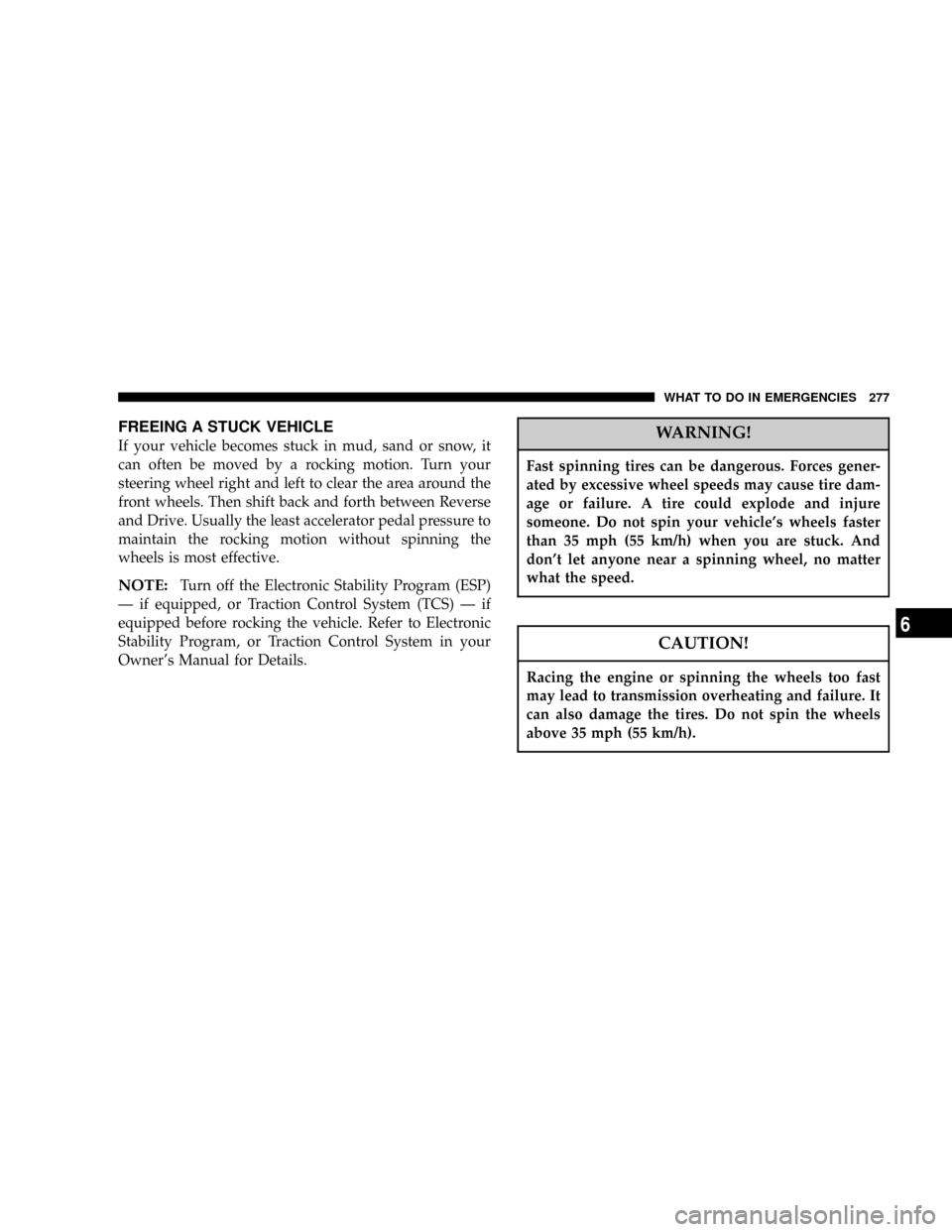2005 CHRYSLER 300 engine overheat
[x] Cancel search: engine overheatPage 265 of 374

NOTE:There are steps that you can take to slow down
an impending overheat condition. If your air conditioner
is on, turn it off. The air conditioning system adds heat to
the engine cooling system and turning off the A/C
removes this heat. You can also turn the Temperature
control to maximum heat, the Mode control to floor, and
the fan control to High. This allows the heater core to act
as a supplement to the radiator and aids in removing heat
from the engine cooling system.
CAUTION!
Driving with a hot cooling system could damage
your vehicle. If temperature gauge reads ªHº, pull
over and stop the vehicle. Idle the vehicle with the
air conditioner turned off until the pointer drops
back into the normal range. If the pointer remains on
the ªHº, turn the engine off immediately, and call for
service.
WARNING!
A hot engine cooling system is dangerous. You or
others could be badly burned by steam or boiling
coolant. You may want to call a service center if your
vehicle overheats. If you decide to look under the
hood yourself, see Section 7, Maintenance, of this
manual. Follow the warnings under the Cooling
System Pressure Cap paragraph.
JACKING AND TIRE CHANGING
WARNING!
Do not attempt to change a tire on the side of the
vehicle close to moving traffic. Pull far enough off
the road to avoid the danger of being hit when
operating the jack or changing the wheel.
WHAT TO DO IN EMERGENCIES 265
6
Page 277 of 374

FREEING A STUCK VEHICLE
If your vehicle becomes stuck in mud, sand or snow, it
can often be moved by a rocking motion. Turn your
steering wheel right and left to clear the area around the
front wheels. Then shift back and forth between Reverse
and Drive. Usually the least accelerator pedal pressure to
maintain the rocking motion without spinning the
wheels is most effective.
NOTE:Turn off the Electronic Stability Program (ESP)
Ð if equipped, or Traction Control System (TCS) Ð if
equipped before rocking the vehicle. Refer to Electronic
Stability Program, or Traction Control System in your
Owner's Manual for Details.
WARNING!
Fast spinning tires can be dangerous. Forces gener-
ated by excessive wheel speeds may cause tire dam-
age or failure. A tire could explode and injure
someone. Do not spin your vehicle's wheels faster
than 35 mph (55 km/h) when you are stuck. And
don't let anyone near a spinning wheel, no matter
what the speed.
CAUTION!
Racing the engine or spinning the wheels too fast
may lead to transmission overheating and failure. It
can also damage the tires. Do not spin the wheels
above 35 mph (55 km/h).
WHAT TO DO IN EMERGENCIES 277
6
Page 296 of 374

WARNING!
The air cleaner can provide a measure of protection
in the case of engine backfire. Do not remove the air
cleaner unless such removal is necessary for repair or
maintenance. Make sure that no one is near the
engine compartment before starting the vehicle with
the air cleaner removed. Failure to do so can result in
serious personal injury.
Fuel Filter
A plugged fuel filter can cause stalling, limit the speed at
which a vehicle can be driven or cause hard starting.
Should an excessive amount of dirt accumulate in the
fuel tank, filter replacement may be necessary. See your
local dealer for service.
Catalytic Converter
The catalytic converter requires the use of unleaded fuel
only. Leaded gasoline will destroy the effectiveness of the
catalyst as an emission control device.Under normal operating conditions, the catalytic con-
verter will not require maintenance. However, it is im-
portant to keep the engine properly tuned to assure
proper catalyst operation and prevent possible catalyst
damage.
CAUTION!
Damage to the catalytic converter can result if your
vehicle is not kept in proper operating condition. In
the event of engine malfunction, particularly involv-
ing engine misfire or other apparent loss of perfor-
mance, have your vehicle serviced promptly. Contin-
ued operation of your vehicle with a severe
malfunction could cause the converter to overheat,
resulting in possible damage to the converter and the
vehicle.
NOTE:Intentional tampering with emissions control
systems can result in civil penalties being assessed
against you.
296 MAINTAINING YOUR VEHICLE
Page 297 of 374

WARNING!
A hot exhaust system can start a fire if you park over
materials that can burn. Such materials might be
grass or leaves coming into contact with your ex-
haust system. Do not park or operate your vehicle in
areas where your exhaust system can contact any-
thing that can burn.
In unusual situations involving grossly malfunctioning
engine operation, a scorching odor may indicate severe
and abnormal catalyst overheating. If this occurs, the
vehicle should be stopped, the engine shut off and the
vehicle allowed to cool. Thereafter, service, including a
tune-up to manufacturer's specifications, should be ob-
tained immediately.To minimize the possibility of catalyst damage:
²Do not shut off the engine or interrupt the ignition
when the transmission is in gear and the vehicle is in
motion.
²Do not try to start engine by pushing or towing the
vehicle.
²Do not idle the engine with any spark plug wires
disconnected or removed, such as when diagnostic
testing, or for prolonged periods during very rough
idling or malfunctioning operating conditions.
Maintenance-Free Battery
The top of the MAINTENANCE-FREE battery is perma-
nently sealed. You will never have to add water, nor is
periodic maintenance required.
MAINTAINING YOUR VEHICLE 297
7
Page 305 of 374

Adding Coolant
When adding coolant, or refilling the system, a minimum
of 50% solution of ethylene glycol antifreeze coolant in
water should be used. Higher concentrations (not to
exceed 70%) are required if temperatures below234ÉF
(237ÉC) are anticipated.
Use only high purity water such as distilled or deionized
water when mixing the water/antifreeze solution. The
use of lower quality water will reduce the amount of
corrosion protection in the engine cooling system.
Please note that it is the owner's responsibility to main-
tain the proper level of protection against freezing ac-
cording to the temperatures occurring in the area where
the vehicle is operated.
NOTE:Mixing coolant types will decrease the life of the
engine coolant and will require more frequent coolant
changes.
Coolant Pressure Cap
The coolant pressure cap must be fully tightened to
prevent loss of coolant, and to insure that coolant will
return to the coolant bottle from the overflow tank. Thecoolant pressure cap should be inspected and cleaned if
there is any accumulation of foreign material on the
sealing surfaces.
WARNING!
²The warning words ªDO NOT OPEN HOTº on
the coolant pressure cap are a safety precaution.
Never add coolant to the cooling system when the
engine is overheated. Do not loosen or remove the
coolant pressure cap to cool an overheated engine.
Heat causes pressure to build up in the cooling
system. To prevent scalding or injury, do not
remove the coolant pressure cap while the system
is hot or under pressure.
²Do not use a pressure cap other than the one
specified for your vehicle. Personal injury or
engine damage may result.
MAINTAINING YOUR VEHICLE 305
7
Page 365 of 374

Emergency, In Case of
Overheating......................... 264
Emission Control System Maintenance....288,336
Engine............................285,286
Air Cleaner.......................... 296
Air Cleaner Filter..................... 295
Block Heater......................... 209
Break-In Recommendations............... 57
Checking Oil Level.................290,291
Compartment.....................285,286
Coolant............................ 333
Cooling............................ 303
Exhaust Gas Caution.................. 253
Fails to Start......................... 208
Fuel Requirements.................250,332
Oil ..........................290,332,333
Oil Change Interval................... 292
Oil Selection......................292,332
Oil Synthetic......................... 294
Overheating......................... 264
Temperature Gauge................... 143
Enhanced Accident Response Feature......... 43
Event Data Recorder..................... 48Exhaust Gas Caution...............58,253,303
Exhaust System........................ 302
Exterior Folding Mirrors.................. 66
Filters
Air Cleaner.......................... 295
Air Conditioning..................203,300
Engine Fuel......................... 296
Engine Oil.......................295,333
Engine Oil Disposal................... 294
Flashers
Hazard Warning...................... 264
Turn Signal.......................... 140
Flash-To-Pass.......................... 106
Flat Tire Changing...................... 265
Floor Console.......................... 130
Fluid Capacities........................ 332
Fluid Leaks............................ 59
Fluid Level Checks
Brake.............................. 334
Power Steering....................300,334
Fog Lights.........................105,140
Folding Rear Seat....................... 97
INDEX 365
10
Page 369 of 374

Electric Remote....................... 67
Exterior Folding....................... 66
Heated.............................. 67
Outside............................. 66
Rearview............................ 65
Vanity.............................. 68
Modifications/Alterations, Vehicle............ 7
Monitor, Tire Pressure System............. 243
Mopar Parts........................289,356
Multi-Function Control Lever.............. 103
New Vehicle Break-In Period............... 57
Occupant Classification System............. 45
Occupant Restraints...................... 29
Octane Rating, Gasoline.................. 250
Oil, Engine.........................290,333
Capacity............................ 332
Change Interval...................... 292
Checking........................290,291
Disposal............................ 294
Filter...........................295,333
Filter Disposal....................... 294Identification Logo.................... 293
Materials Added to.................... 294
Recommendation..................292,332
Synthetic........................... 294
Viscosity......................293,294,332
Onboard Diagnostic System............287,288
Opener, Garage Door.................... 119
Operator Manuals........................ 4
Overhead Console...................... 118
Overhead Travel Information Center......... 118
Overheating, Engine..................144,264
Owner's Manual......................4,356
Panic Alarm........................... 22
Parking Brake......................... 222
Parking On Hill........................ 223
Passing Light.......................... 106
Pedals, Adjustable....................... 98
Personal Settings....................... 154
Pets.................................. 57
Phone, Cellular......................... 68
Phone, Hands-Free....................... 68
Placard, Tire and Loading Information....... 232
INDEX 369
10